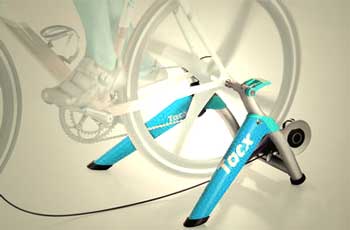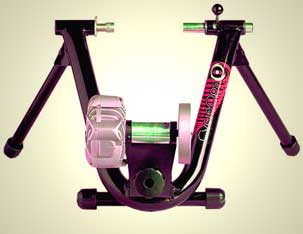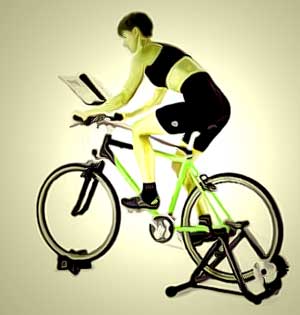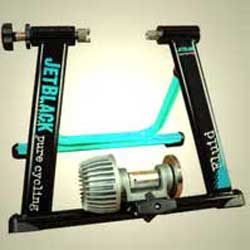Different Types of Bicycle Indoor Training Stands
There are numerous different bicycle indoor training stands. Each version has its own advantages and disadvantages. We have broken each one down so you can get a clearer idea of how each stationary bike stand works.
Magnetic Trainer – generates resistance via a roller-driven magnetic flywheel
Fluid Trainer – generates resistance through the marriage of fluid chambers with a magnetic flywheel
Wind Trainer – applies resistance to the cyclist’s rear wheel using a pedal driven fan
Pivot Trainer – gives a more realistic feel by allowing side to side motion
Rim Trainer – two wheels that run on the rear tire rim – this propels a belt attached to a magnetic resistance unit
Virtual Reality Trainer – a sophisticated cycling simulator – not for shallow pockets, but well worth a look
Bicycle Roller Trainer – uses the resistance of your bike tires on the rollers)
Things To Consider When Buying A Stationary Bicycle Stand
- How much do you want to spend?
- What do you expect from your bicycle trainer?
- How will you use it? – Serious training or casual exercise?
- What type of Bicycle Indoor Training Stand suits you?
Magnetic, Fluid, Pivot, Virtual Reality, Rim Drive, Wind, Rollers. - What features are essential? – Desirable?
- How often will you use it?
- Which type of bike will you use with it? – Road, MTB etc?
- Does it have a sturdy construction?
- How noisy is it?
- Have you tried various models to find which one actually works for you?
- Will you need to buy sweat guards to protect your bike?
- How portable is it? – How portable does it need to be?
- What is the resistance like? – How do you increase the resistance?
- What gadgets do you want or need?
- Do you have room for a stationary bicycle stand?
Why Use Bicycle Indoor Training Stands?
A Stationary Bicycle Stand is equipment designed to accommodate the needs of cyclists who choose to ride their bicycle indoors.
Basically, by hooking up your regular bike to the hard frame, it is transformed into an indoor bike trainer.
There are both Advantages and Disadvantages, to using an indoor bicycle stand. However indoor bicycle trainers are great for cyclists who want to:
- Maintain fitness and muscle tone during the winter months or just on wet-weather days.
- Practice specific techniques in a regulated setting.
- Work out after dark without the hazards associated with night-riding.
- Ease back into riding after a cycling injury.
- Take a quick hard spin without having to worry about all the prep involved in a road-ride.
- Exercise and multi-task – ie watch TV, babysit, talk on the phone, listen to music, play video games or read.
- Save space in their apartment by not having an indoor and an outdoor bike.
- Ride without external safety concerns.
How A Stationary Bicycle Stand Works
Bicycle Indoor Training Stands Are Made Up Of:
- A rear-axle bicycle stand
- A roller
- Resistance apparatus
Your bike is attached to the bicycle stand by its rear axle. This is done by simply raising it off the floor a few inches /centimetres.
The rear wheel of your bicycle is placed against the roller. The roller is driven when you rotate the rear wheel by pedalling.
A riser block is used to lift the front wheel up to the corresponding height.
A resistance apparatus is affixed to the roller to make cycling more difficult.
**Depending on the model you purchase, you may be able to choose the level of resistance.
However, the more basic bicycle trainers rely on you changing your gears to vary resistance.
Advantages of Bicycle Indoor Training Stands
 Bicycle Indoor Training Stands:
Bicycle Indoor Training Stands:
- Are often much cheaper than shelling out for a new exercise-bike – although only if you already have a bike that you can use.
- Can simulate a cycling experience closer to reality than the exercise-bike does.
- Provide the opportunity to cycle day or night – in a safe, controlled, weather-free environment.
- Is able to offer greater levels of resistance – via the use of your bike gears.
- Are perfect for interval training.
- Provide a safe environment for improving new techniques or trying out new equipment.
- Terrific for testing – under pressure – any mechanical adjustments or new additions that you have made to your bike.
- Are becoming more and more sophisticated – especially with the virtual reality trainers, that come with computer software that simulates real cycling conditions, gives feedback and allows for a superior level of control and precision.
- Allow for training DVDs to be watched during a workout.
- Help injured riders with rehabilitation exercises and being able to return to cycling at their own pace – for example when they tire or find that they are in pain then they can simply stop.
- Mean that when you breakdown or are injured, there isn’t far to go to get home and to get help.
- Make road rage a moot point.
- Allow beginner riders to master their bike before hitting the traffic.
- Help cyclists with building their cardio fitness, strength, speed, flexibility and refining their riding techniques and strategies.
Disadvantages of Bicycle Indoor Training Stands
Bicycle Indoor Training Stands:
- Place a strain on your bike frame and wear out the tires quickly.
(You should use an old tire or a smooth trainer tire aka slick tire on the stationary bicycle stand – NOT your expensive ones!). - Are boring to ride without any other distractions.
- Require trainer tires to be taken off and swapped for road tires every time you want to go for an external ride.
- Don’t work well with MTB knobby tires.
- Can be expensive with wear and tear on your bicycle.
- Still can tip over – are not 100% stable.
- Are hot and sweaty work, without the wind blowing in your face. You may need to invest in a sweat guard for your bicycle frame.
- Requires your road bike’s cyclometer-sensor to be transferred over from the front tire to the back wheel because the front tire doesn’t rotate on an indoor bicycle trainer.
